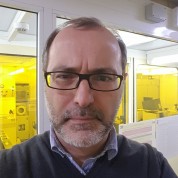Fondazione Bruno Kessler (FBK) – Center for Materials and Microsystems, Trento, Italy

Dr. Leandro Lorenzelli
Bio
Dr. Leandro Lorenzelli, Head of the Microsystems Research Unit at FBK-Center for Materials and Microsystems (Trento, Italy), received the Laurea degree in Electronic Engineering at the University of Genova in 1994 and a PhD in 1998 in Electronics Materials and Technologies at University of Trento.
His main research interests are in the fields of the technologies for MEMS-sensors, lab on chip and flexible sensors. His objective has been to strengthen the scientific visibility of FBK-CMM in the sector of BioMEMS and microsensors, to improve the reliability of MEMS components, and to set up initiatives for the technological transfer. Just by way of an example, with his research unit he developed MEMS devices implemented in the micro-thrusters of the satellites of ESA missions GAIA, and ESA LISA Pathfinder space missions.
He is author and co-author of about 90 scientific publications and of 4 patents. He has been coordinator of European projects in the areas of innovative technologies for flexible electronics, microsystems for food analysis quality control and water monitoring, and for sensors in prosthetic applications. He has been program chair and speaker in many international conferences (e.g. IEEE Sensors, Eurosensors and MicroNanoEngineering).
Project
RP9: 3D printing methodologies for sensor system packaging (ESR9, FBK)
In many applications and research activities involving micro/nanosensors, the packaging issues have been often underestimated by compromising important features as sensors sensitivity, reproducibility and throughput. The integration of multisensory systems on robots or buoys will require advanced packaging strategies. Recent advances in 3D printing have demonstrated the possibility to creating packages with polymers, metals, composites and ceramics, which have higher adaptability to different environmental conditions. 3D printing enables the creation of complex geometric shapes and merging of selected functional components into any configuration, thus supplying a new approach for the fabrication of multifunctional end-use devices that can potentially combine optical, chemical, electronic, electromagnetic, fluidic, thermal and acoustic features. Starting from this premise, ESR9 will: (1) model, design and create multi-process 3D printing methodologies; (2) suggest 3D printing architectures for more sophisticated devices with a higher level of automation and increased integration/packaging level; (3) develop packages to integrates the sensory system developed by other ESRs in AQUASENSE.

